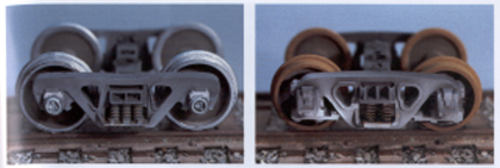What is the proper color for freight car trucks and wheels? There are many types of freight car trucks, but they fall in two main categories, solid bearing or roller bearing. Solid bearing trucks were common prior to the 1960's but are rare today. Roller bearings were required for all new and rebuilt 100-ton cars as of 1966, all new cars as of 1968, and all new a rebuilt cars as of 1970.
Model train trucks are made of metal, styrene, or delrin plastic. They need to be painted with a thin coat of paint that will not obscure the detail, a flat finish per the prototype, and good adhesion. One paint I have found suitable for slippery plastics is Floquil with Dio-Sol as a thinner. I would recommend painting the truck sideframes with an air brush or a soft paintbrush. I prefer the airbrush because it gets the best coverage, especially the finer details.
Roller Bearing Trucks: Most of these trucks start out either painted black or painted to match the car color. Once in service, they get dirty and take on new colors. Most sideframes become dark gray with varying amounts of rust. This is the color that we want to approximate. I start with 4 parts Grimy Black, 1 part Reefer White, and 1 part Rust. You can add more rust to the mix to vary the color. Some sideframes have rusty streaks which can be simulated by drybrushing 1 part Roof Brown to 1 part Rust. Some trucks are very rusty which can be simulated with a wash made from the Rust and Roof Brown. Just allow this mixture to flow from the top of the truck to the bottom. The color of the springs will vary from the sideframe color to dark rust. I usually paint them the same color as the sideframe, and then drybrush them with the Rust/Roof Brown mixture.
The metal castings above the roller-bearing assembly is the roller-bearing adapter. This piece is often a reddish color. I make a mixture of 1 drop Tuscan Red, 1 drop Grimy Black, and 40 drops of Reefer White. This color is drybrushed onto the assembly. The color of the roller-bearing end caps ranges from that of the sideframe to gray or rust.
In service, the trucks become weathered and accumulate dirt. The weathering color varies depending upon what part of the country the car has been predominantly run in. See my article on Steam Locomotive Weathering for paint mixtures for various regions of the United States. I spray the truck sideframes from the bottom to simulate this dirt and grime accumulation.
Wheels and axels are always left unpainted so that cracks and other flaws can be easily seen. I generally paint mine with Roof Brown to simulate the rust that occurs over time. Clean overspray off the tread and flange area with Dio-Sol on a Q-Tip. The treads and flanges remain shiny due to the constant friction with the rail. If you do not use metal wheelsets, this is impossible to reproduce in a model, since friction with the rail will rub off any paint that you try to apply.
Solid Bearing Trucks: The painting techniques outlined above hold true for solid bearing trucks. The truck sideframes will be painted the same way, and weathered the same. Wheels will be painted with Roof Brown to Grimy Black depending upon how long the wheel has been in service. The rusty Roof Brown will be for fairly new wheels, and the Grimy Black will be for wheels that have been in service for some time. The reason for the color difference is that on these type trucks, the journal is used to lubricate the axel ends, and is packed with grease. As the grease spreads to the wheel through use, the black accumulated onto the face of the wheel. Sometimes a little baking soda can be added to the Grimy Black paint to roughen the texture due to accumulation of grease and dirt.
The above painting techniques are simple, and will give your model freight cars a very realistic look. Check color photographs to determine if the trucks for your particular railroad were painted the color of the car, or just black.

